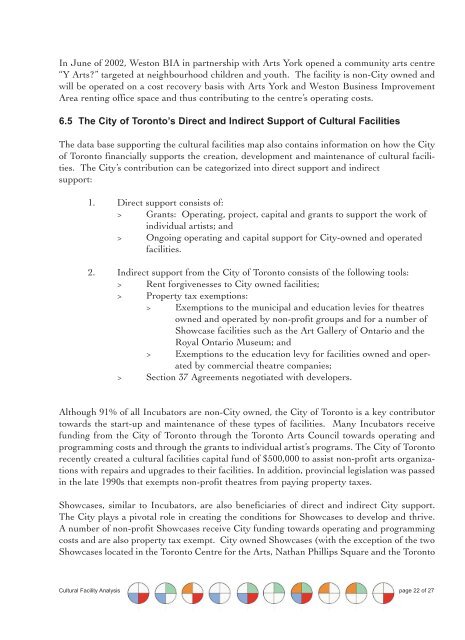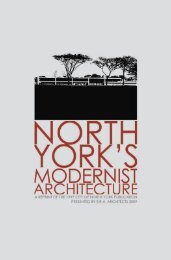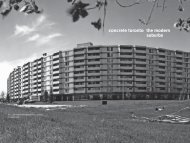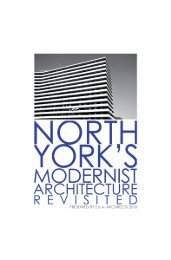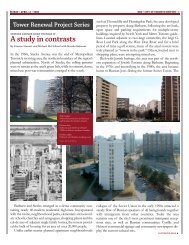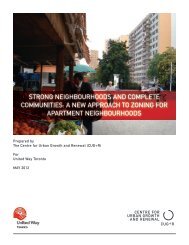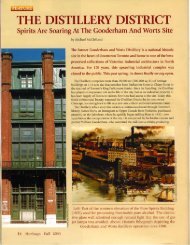A Map of Toronto's Cultural Facilities - ERA Architects Inc.
A Map of Toronto's Cultural Facilities - ERA Architects Inc.
A Map of Toronto's Cultural Facilities - ERA Architects Inc.
Create successful ePaper yourself
Turn your PDF publications into a flip-book with our unique Google optimized e-Paper software.
In June <strong>of</strong> 2002, Weston BIA in partnership with Arts York opened a community arts centre<br />
“Y Arts?” targeted at neighbourhood children and youth. The facility is non-City owned and<br />
will be operated on a cost recovery basis with Arts York and Weston Business Improvement<br />
Area renting <strong>of</strong>fice space and thus contributing to the centre’s operating costs.<br />
6.5 The City <strong>of</strong> Toronto’s Direct and Indirect Support <strong>of</strong> <strong>Cultural</strong> <strong>Facilities</strong><br />
The data base supporting the cultural facilities map also contains information on how the City<br />
<strong>of</strong> Toronto financially supports the creation, development and maintenance <strong>of</strong> cultural facilities.<br />
The City’s contribution can be categorized into direct support and indirect<br />
support:<br />
1. Direct support consists <strong>of</strong>:<br />
> Grants: Operating, project, capital and grants to support the work <strong>of</strong><br />
individual artists; and<br />
> Ongoing operating and capital support for City-owned and operated<br />
facilities.<br />
2. Indirect support from the City <strong>of</strong> Toronto consists <strong>of</strong> the following tools:<br />
> Rent forgivenesses to City owned facilities;<br />
> Property tax exemptions:<br />
> Exemptions to the municipal and education levies for theatres<br />
owned and operated by non-pr<strong>of</strong>it groups and for a number <strong>of</strong><br />
Showcase facilities such as the Art Gallery <strong>of</strong> Ontario and the<br />
Royal Ontario Museum; and<br />
> Exemptions to the education levy for facilities owned and operated<br />
by commercial theatre companies;<br />
> Section 37 Agreements negotiated with developers.<br />
Although 91% <strong>of</strong> all <strong>Inc</strong>ubators are non-City owned, the City <strong>of</strong> Toronto is a key contributor<br />
towards the start-up and maintenance <strong>of</strong> these types <strong>of</strong> facilities. Many <strong>Inc</strong>ubators receive<br />
funding from the City <strong>of</strong> Toronto through the Toronto Arts Council towards operating and<br />
programming costs and through the grants to individual artist’s programs. The City <strong>of</strong> Toronto<br />
recently created a cultural facilities capital fund <strong>of</strong> $500,000 to assist non-pr<strong>of</strong>it arts organizations<br />
with repairs and upgrades to their facilities. In addition, provincial legislation was passed<br />
in the late 1990s that exempts non-pr<strong>of</strong>it theatres from paying property taxes.<br />
Showcases, similar to <strong>Inc</strong>ubators, are also beneficiaries <strong>of</strong> direct and indirect City support.<br />
The City plays a pivotal role in creating the conditions for Showcases to develop and thrive.<br />
A number <strong>of</strong> non-pr<strong>of</strong>it Showcases receive City funding towards operating and programming<br />
costs and are also property tax exempt. City owned Showcases (with the exception <strong>of</strong> the two<br />
Showcases located in the Toronto Centre for the Arts, Nathan Phillips Square and the Toronto<br />
<strong>Cultural</strong> Facility Analysis page 22 <strong>of</strong> 27


